|
|

This chapter explains how to install the BPX switch cards, check for a 9.6 or 19.2 Gbps backplane, connect line and trunk cables, connect peripherals, connect to a network management station, initial power up, and initial configuration:
Before proceeding to this chapter, you should first complete the procedures in either:
and before that, the procedures in either:
 |
Caution Ground yourself before handling BPX switch cards by placing a wrist strap on your wrist and clipping the strap lead to the cabinet, or use the wrist strap that is connected to the cabinet. |
The card shelf in the BPX switch has card slots numbered from 1 to 15, as viewed from left to right from the front of the cabinet. Front and rear views of the BPX switch card shelf are shown in Figure 13-1 and Figure 13-2, respectively.
Here is a summary of the card installation rules for the BPX switch:
Non-Redundant Nodes:
Redundant Nodes:
 |
Note In some cases, it may be possible to operate two of the three types of BCCs with their proper backcards temporarily for maintenance purposes, that is, replacing a failed controller card. Contact Customer Service for assistance. |


Before following the front card installation procedure, carefully note and perform each of the following cautionary steps:
 |
Caution Ground yourself before handling BPX switch cards by placing a wrist strap on your wrist and clipping the strap lead to the cabinet, or use the wrist strap that is connected to the cabinet. |
 |
Caution You must use Blank Front Card and Rear Face Plates to fill/cover empty card slots to eliminate Radio Frequency Interference (RFI) and Electromagnetic Interference (EMI) and to ensure correct air flow through the card cage. |
Systems may be shipped with empty shelves, with filler cards or with plug-in cards installed. If filler cards are installed in each slot, then you must replace some of them may with functional cards. The front cards are held captive mechanically by the Air Intake Grille and can not be removed until the lower Air Intake Grille is released.
 |
Caution Do not attempt to remove a front card from the BPX switch cabinet until the Air Intake Grille is released and lowered or the Air Intake Grille and/or card extractors may be damaged. |
 |
Caution Before any card is installed, always examine the chassis backplane and card cage guides for any signs of loose or misplaced EMI gasketing. Examine the backplane connectors for bent or damaged connection or pre-power pins. |
To remove or to install a front card:
 |
Note It is a good idea to turn off power when initially installing cards. When replacing cards on an operating BPX switch, it is not necessary to turn off power because the cards are hot pluggable. |
Step 2 Locate the small access hole in the top center of the front Air Intake Grille below the card slots (see Figure 13-3 for location).
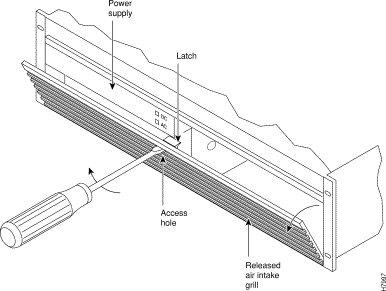
Step 3 Insert a small slotted blade screwdriver (0.20/0.25 inch blade width) into the access hole until it stops (approximately 1 inch).
Step 4 Carefully rotate the screwdriver approximately a quarter turn in either direction. The top of the Air Intake Grille should spring out.
Step 5 Remove Air Intake Grille.
Step 6 To remove a card, rotate the extractor handles at the top and bottom of the card to release the card and slide it out.
Step 7 To insert a new card, position the rear card guides over the appropriate slots at the top and bottom of the card cage.
Step 8 Gently slide the card in all the way to the rear of the slot and seat the board by fully seating both extractor handles. The handles should snap back to a vertical position when seated.
 |
Note The card should slide in with slight friction on the adjacent board's EMI gaskets. Investigate any binding. Do not use excessive force. |
 |
Caution Ground yourself before handling BPX switch cards by placing a wrist strap on your wrist and clipping the strap lead to the cabinet, or use the wrist strap that is connected to the cabinet. |
The optical ports contain an information label as shown in Figure 13-4.

 |
Warning Invisible radiation may be emitted from the optical ports of the single-mode or multi-mode products when no fiber cable is connected. Avoid exposure and do not look into open apertures. (For translated versions of this warning, refer to the Regulatory Compliance and Safety Information that accompanied your equipment.) |
 |
Warning Class 1 laser product. (For translated versions of this warning, refer to the Regulatory Compliance and Safety Information that accompanied your equipment.) |
 |
Warning Laser radiation when open. (For translated versions of this warning, refer to the Regulatory Compliance and Safety Information that accompanied your equipment.) |
To install back cards:
Step 2 For existing installations, remove any cables that may be attached and label them so they may be replaced in the same location.
Step 3 Loosen the captive mounting screws on both top and bottom of the line module faceplate by using a slotted blade screwdriver (see Figure 13-5).
Step 4 Lift the extractor handles at the top and bottom, and slide out the line module.
Step 5 To re-insert the line module, locate the corner edges of the card into the appropriate guide slots at the top and bottom of the card cage. Gently slide the card in all the way to the rear of the slot and push to seat the card in the connector.
 |
Note The card should slide in easily. Investigate any binding. Do not use excessive force. |
Step 6 Screw in the captive screws.
Step 7 Replace any cables that may have been removed in step 2.
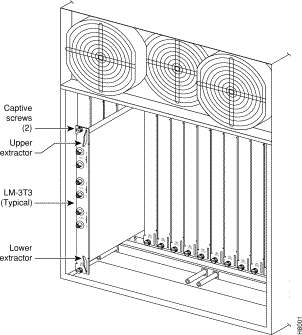
Operation of the BPX Switch at 19.2 Gbps entails these requirements:
You can visually identify the 19.2 backplane by the small white card slot fan fuses at the bottom rear of the backplane. These fan fuses are approximately 1/4 inch high and 1/8 inch wide. The 9.6 Gbps backplane does not have these fuses.

If the BPX Switch is a late model, then a 19.2 Gbps backplane is installed. You can verify this by running the dspbpnv command which will display "Word #2 =0001" if the backplane NOVRAM has been programmed. If anything else is displayed, you'll have to visually check the backplane for the fuses.
If the backplane is a 19.2 Gbps backplane, but the backplane NOVRAM has not been set to display Word #2 =0001, then you can use the cnfbpnv command to program the NOVRAM.
To use the cnfbpnv command to program the NOVRAM:
Are you sure this is a new backplane (y/n).
Step 2 Enter y
Step 3 Confirm that the change has been made by entering dspbpnv to confirm the response:
Word #2 =0001
 |
Note If for some reason the change does not take place, it will be necessary to change the backplane NOVRAM. Contact customer service. |
Step 4 Enter switchcc so that the change will be recognized by the switch software.
If the backplane is not a 19.2 Gbps backplane, then it will be necessary to install a 19.2 Gbps backplane to obtain 19.2 Gbps operation. Contact Cisco Customer Service.
BCC-4 cards support 19.2 Gbps performance of the BXM cards.
Note that BCC-4 cards requires that the backplane be either a 9.6 or 19.2 Gbps backplane. Refer to the previous section, Verifying 9.6 or 19.2 Gbps Backplane.
To upgrade to BCC-4 cards:
 |
Note If the control card being replaced is a BCC-3, the BCC-3 backcard (BCC-3-bc) can be used as it is used with both the BCC-3 and BCC-4 front cards. |
Step 2 Replace with new BCC-4 front and back cards.
Step 3 Wait for the standby updates on the newly installed standby BCC-4 to complete.
Step 4 Issue a switchcc command to utilize the newly installed BCC-4.
Step 5 Verify that the network is stable.
Step 6 Remove the current standby BCC front and back card.
Step 7 Replace with new BCC-4 front and back cards that are identical to the current active BCC-4.
Step 8 Wait for the standby updates on the newly installed standby BCC-4 to complete.
Step 9 The BCC-4 physical upgrade is now complete.
After step 2, the node will contain a mix of an old type BCC and the new type BCC-4. This condition is permitted only while the standby updates to the new BCC are in progress, which will take less than one hour.
You should keep the time during which this mixture of BCC types exists to a minimum by immediately replacing the second old type BCC with the matching BCC of the new type.
You can set up port redundancy by installing two identical front and back card sets, connecting them with a Y-cable on each paired port, then specifying redundancy with the addyred command. Redundancy applies to the entire card and is not port or line-specific.
The commands that apply to Y-cable redundancy are:
During normal operation, the primary set is "active" and carrying traffic, while the secondary set is in "standby." The primary set configuration is the configuration for both the primary and redundant set. If you reset the primary cards or the primary card set becomes inactive for another reason, the secondary card set becomes active.
BPX card sets may consist of the following:
Figure 13-7 illustrates the typical Y-cable connection of primary and secondary card sets. The single end of a Y-cable (or base of the "Y") goes to the user equipment. One of the two connectors at the split end goes to the primary back card, and the other connector goes to the secondary back card.
Switching to the standby card occurs only if the secondary card set is in a "Standby" or a "Standby-T" state (but not "Failed"). See the dspcds definition for information on these states.
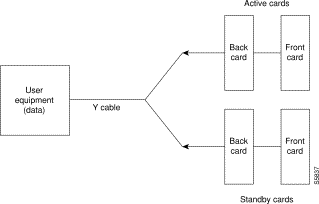
Terminating connections is possible at only a primary slot and not at a secondary slot. See the addcon description.
On multiport card sets, each primary port is connected by a Y-cable to a secondary (redundant) port. Port 1 of the primary card set must be paired to port 1 of the secondary card set, and so on. Figure 13-8 illustrates the cabling for a multiport card set.
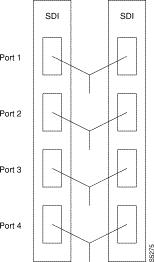
If the secondary card set becomes active, the primary card set goes into the standby state. For the primary card set to serve as a backup, it must be a complete set and not have failed status.
You can execute addyred even if the primary and secondary slots are empty. If cards reside in the primary and secondary slots, the system checks for card compatibility. Two types of incompatibility can occur: back card and jumper or cable.
BPX mismatch types:
If incompatibilities exist, the message "Y-Cable Conflict" appears on screen. Specific conflicts are listed in reverse video in the Y-Cable Redundancy screen. See the dspyred description in the Cisco WAN Switching Command Reference for details.
Y-Cable redundancy is supported for both the UXM and BXM trunk cards at the edge of the ATM cloud.
The procedures in this section provide installation instructions for the SONET Automatic Protection System (APS) Redundant Frame Assemblies and backcards. These may be used to provide line and card redundancy for BXM OC-3 and OC-12 cards.
The APS protocols supported by the BXM are listed in Table 13-1 and shown in Figure 13-9 and Figure 13-10.
| The APS 1:1 redundancy provides line redundancy, using adjacent lines on the same BXM backcard. |
| The APS 1+1 redundancy provides card and line redundancy, using the same numbered ports on adjacent BXM backcards. |
APS 1:1 redundancy provides line redundancy only and is supported with the standard BXM OC-3 and OC-12 front and back cards.
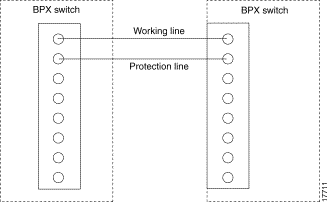
APS 1+1 redundancy provides both card and line redundancy. It uses the standard BXM OC-3 and OC-12 front cards but requires a special APS Redundant Backplane and APS Redundant backcards.
With previous card cages, because of the positioning of mechanical dividers, the APS card pairs could be inserted only in slots 2 through 5 and 10 through 13. The mechanical dividers are located at slots 1 and 2, 5 and 6, 9 and 10, and 13 and 14.
With current card cages, this limitation is removed so that the APS card pairs can be located anywhere except BCC cards slots 7 and 8, and ASM card slot 15. An APS 1+1 redundant card pair must be in adjacent slots (2,3 or 4,5 and so on).
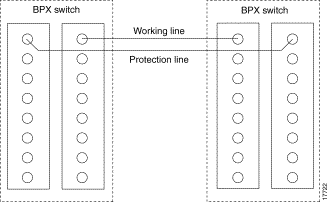
To install APS Redundant Frame Assembly and backcards:
 |
Warning Nylon standoffs on the APS Redundant Frame Assembly must be in place to prevent shorting against -48 VDC pins and ground pins on the BPX Midplane. |
Step 2 Verify that nylon standoffs are securely installed on APS Redundant Frame Assembly (see Figure 13-11).
Step 3 Carefully slide APS Redundancy Frame Assembly and APS cards into selected side-by-side slots at the back of the BPX shelf (see Figure 13-12). Slide the APS Redundancy Frame Assembly and cards into the BPX shelf until snug against the BPX midplane (see Figure 13-13).
Step 4 Going back and forth between the screws, gradually tighten retaining screws at top and bottom of the APS backcards until all are secure.
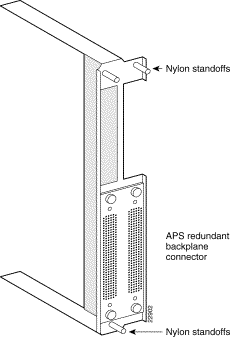

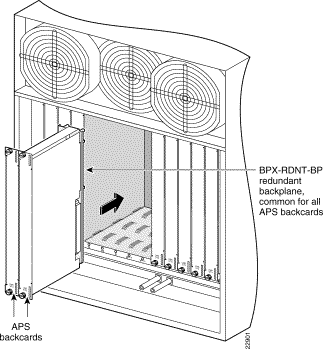
![]()
![]()
![]()
![]()
![]()
![]()
![]()
![]()
Posted: Fri Jul 27 17:31:10 PDT 2001
All contents are Copyright © 1992--2001 Cisco Systems, Inc. All rights reserved.
Important Notices and Privacy Statement.